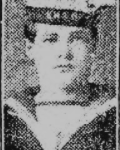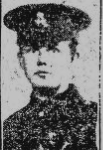BORN HULL 04/12/1896. SON OF THOMAS GILBERT MIDGELY & SUSAN ANN BUDGEN, OF 2 , WENTWORTH STREET, HULL ADDRESS (1901 CENSUS) AND 31 MULGRAVE STREET (1911 CENSUS). HE WAS A WOOD TURNER BY TRADE. JOINED TH ROYAL NAVY ON 28/06/1913. HIS SISTER MARTHA HART LIVED 11 HAROLD’S TERRACE, WALLER STREET, HULL. HE HAD SPENT SOME TIME AT THE SPRING BANK OPHANAGE AND HAD JOINED THE NAVY TWELVE MONTHS AGO, AGED 15. HE WAS LOST AT SEA, DURING THE BATTLE OF THE CORONNEL. HMS ‘MONMOUTH’ WAS SUNK ON 01/11/1914, WITH 738 CREW. THERE WERE NO SURVIVORS. HE WAS AGED 16. HE IS LISTED ON THE WALLER STREET ROLL OF HONOUR.
HIS FATHER, THOMAS, WAS A GROOM, AND SERVED IN THE DRAGOON GUARDS, DURING THE WAR. HE DIED IN 1919 AND IS BURIED AT HULL’S HEDON ROAD CEMETERY IN A CWGC GRAVE. HIS BROTHER, PRIVATE, TOM MIDGLEY, 20TH HUSSARS, WAS ALSO KILLED IN THE WAR.
MONMOUTH HMS British Navy, armoured cruiser; 1901; London & Glasgow Shipbuilding Co.; 9,800 tons; 448x66x24-5; 22,000 Lh.p.; 23-9 knots; triple-expansion engines; Belleville boilers; fourteen 6 in. guns, eight 12pdr., three 3 pdr., 2 T.T. The armoured cruiser MONMOUTH Hms, Capt. Brandt, a ship of about ten years´ service was commissioned at the outbreak of the First World War and sent to the North American Station to strengthen the squadron under Rear-Admiral Sir Christopher Cradock. MONMOUTH arrived on August 22nd, 1914 and from that time was engaged as one of the ships sweeping down the coast of South America in search of the German light cruisers Karlsruhe and Dresden. Eventually, as part of a squadron consisting of the flagship Good Hope (which see), the light cruiser Glasgow and the auxiliary cruiser Otranto, MONMOUTH met the German East Asiatic Squadron under Admiral Graf von Spee off Coronel, Chile. The two German armoured cruisers, Scharnhorst (flagship) and Gneisenau, were armed with eight 8-2 in. guns apiece and greatly outranged the British ships. Three light cruisers, the Dresden, Leipzig and Nurnberg, completed the German squadron, all the units of which were very speedy. The rival forces made contact at about 6 p.m. on November 1st, and, after an hour´s manoeuvring, the superior speed of the Germans placed them in a position to fire at the British ships on the horizon line, silhouetted against the setting sun. The first shot was fired at 7.04 p.m. and in a short time the two British armoured cruisers were on fire. At 7.53 p.m. the flagship Good Hope blew up and sank with the Admiral and all on board, leaving the fight to be maintained by MONMOUTH. The two light ships had been ordered to seek safety in flight, and Glasgow saw MONMOUTH for the last time at about 8.15 p.m. It was then dark and the big cruiser, with a heavy list, was steaming stern on to the seas, which were very rough. Glasgow signalled as she passed “The enemy is following us”, but received no reply. She again signalled, telling her to shape a course to the N.W. clear of the enemy. She then made her best efforts to escape. The darkness was now dispelled by the moon, and this enabled the German cruisers to establish the whereabouts of the British ship. At 9.25 p.m. those on board Glasgow counted 75 gun flashes, and then no more. MONMOUTH, with Capt. Brandt and all her company had foundered. The official complement of MONMOUTH was 678. Read more at wrecksite: https://www.wrecksite.eu/wreck.aspx?135896

